Metal–Organic Frameworks for Electrocatalytic CO2 Reduction into Formic Acid
Abstract
:1. Introduction
2. Evaluation of Catalyst Performances
2.1. FE
2.2. Overpotential and Applied Potential
2.3. Current Density and TOF
3. MOF Materials
3.1. Copper-Based MOFs
3.2. Bismuth-Based MOFs
3.3. Indium-Based MOFs
3.4. Tin-Based MOFs
3.5. Aluminum-Based MOFs
4. MOF-Derived Metal Nanomaterials
4.1. Copper-Based Nanomaterials
4.2. Bismuth-Based Nanomaterials
4.3. Lead-Based Nanomaterials
5. MOF-Derived Carbon-Based Nanocomposites
5.1. Copper-Based Nanocomposites
5.2. Bismuth-Based Nanocomposites
5.3. Indium-Based Nanocomposites
6. Bimetallic MOF-Derived Nanocomposites
6.1. Copper and Bismuth-Based Bimetallic Nanocomposites
6.2. Bismuth and Indium-Based Bimetallic Nanocomposites
6.3. Palladium and Gold-Based Bimetallic Nanocomposites
7. Summary and Outlook
Author Contributions
Funding
Data Availability Statement
Conflicts of Interest
References
- Abdelkader-Fernández, V.K.; Fernandes, D.M.; Freire, C. Carbon-based electrocatalysts for CO2 electroreduction produced via MOF, biomass, and other precursors carbonization: A review. J. CO2 Util. 2020, 42, 101350. [Google Scholar] [CrossRef]
- Yang, Z.W.; Chen, J.M.; Qiu, L.Q.; Xie, W.J.; He, L.N. Molecular Engineering of Metal Complexes for Electrocatalytic Carbon Dioxide Reduction: From Adjustment of Intrinsic Activity to Molecular Immobilization. Angew. Chem. Int. Ed. 2022, 61, e202205301. [Google Scholar]
- Mahmood, A.; Guo, W.; Tabassum, H.; Zou, R. Metal-Organic Framework-Based Nanomaterials for Electrocatalysis. Adv. Energy Mater. 2016, 6, 1600423. [Google Scholar] [CrossRef]
- Zhang, W.; Hu, Y.; Ma, L.; Zhu, G.; Wang, Y.; Xue, X.; Chen, R.; Yang, S.; Jin, Z. Progress and Perspective of Electrocatalytic CO2 Reduction for Renewable Carbonaceous Fuels and Chemicals. Adv. Sci. 2018, 5, 1700275. [Google Scholar] [CrossRef]
- Raciti, D.; Wang, C. Recent Advances in CO2 Reduction Electrocatalysis on Copper. ACS Energy Lett. 2018, 3, 1545–1556. [Google Scholar] [CrossRef]
- Wang, Y.; Su, H.; He, Y.; Li, L.; Zhu, S.; Shen, H.; Xie, P.; Fu, X.; Zhou, G.; Feng, C.; et al. Advanced Electrocatalysts with Single-Metal-Atom Active Sites. Chem. Rev. 2020, 120, 12217–12314. [Google Scholar] [CrossRef]
- Masood ul Hasan, I.; Peng, L.; Mao, J.; He, R.; Wang, Y.; Fu, J.; Xu, N.; Qiao, J. Carbon-based metal-free catalysts for electrochemical CO2 reduction: Activity, selectivity, and stability. Carbon Energy 2020, 3, 24–49. [Google Scholar] [CrossRef]
- Fellay, C.; Yan, N.; Dyson, P.J.; Laurenczy, G. Selective formic acid decomposition for high-pressure hydrogen generation: A mechanistic study. Chem. Eur. J. 2009, 15, 3752–3760. [Google Scholar] [CrossRef]
- Liu, M.; Xu, Y.; Meng, Y.; Wang, L.; Wang, H.; Huang, Y.; Onishi, N.; Wang, L.; Fan, Z.; Himeda, Y. Heterogeneous Catalysis for Carbon Dioxide Mediated Hydrogen Storage Technology Based on Formic Acid. Adv. Energy Mater. 2022, 12, 2200817. [Google Scholar] [CrossRef]
- Xia, S.-M.; Yang, Z.-W.; Yao, X.-Y.; Chen, K.-H.; Qiu, L.-Q.; He, L.-N. The synergistic copper/ppm Pd-catalyzed hydrocarboxylation of alkynes with formic acid as a CO surrogate as well as a hydrogen source: An alternative indirect utilization of CO2. Green Chem. 2021, 23, 8089–8095. [Google Scholar] [CrossRef]
- Xia, S.-M.; Yang, Z.-W.; Chen, K.-H.; Wang, N.; He, L.-N. Efficient hydrocarboxylation of alkynes based on carbodiimide-regulated in situ CO generation from HCOOH: An alternative indirect utilization of CO2. Chin. J. Catal. 2022, 43, 1642–1651. [Google Scholar] [CrossRef]
- Evans, H.A.; Mullangi, D.; Deng, Z.; Wang, Y.; Peh, S.B.; Wei, F.; Wang, J.; Brown, C.M.; Zhao, D.; Canepa, P.; et al. Aluminum formate, Al(HCOO)3: An earth-abundant, scalable, and highly selective material for CO2 capture. Sci. Adv. 2022, 8, 1473. [Google Scholar] [CrossRef]
- Mullangi, D.; Evans, H.A.; Yildirim, T.; Wang, Y.; Deng, Z.; Zhang, Z.; Mai, T.T.; Wei, F.; Wang, J.; Hight Walker, A.R.; et al. Noncryogenic Air Separation Using Aluminum Formate Al(HCOO)3 (ALF). J. Am. Chem. Soc. 2023, 145, 9850–9856. [Google Scholar] [CrossRef] [PubMed]
- Zhang, Z.; Deng, Z.; Evans, H.A.; Mullangi, D.; Kang, C.; Peh, S.B.; Wang, Y.; Brown, C.M.; Wang, J.; Canepa, P.; et al. Exclusive Recognition of CO2 from Hydrocarbons by Aluminum Formate with Hydrogen-Confined Pore Cavities. J. Am. Chem. Soc. 2023, 145, 11643–11649. [Google Scholar] [CrossRef] [PubMed]
- Duarah, P.; Haldar, D.; Yadav, V.S.K.; Purkait, M.K. Progress in the electrochemical reduction of CO2 to formic acid: A review on current trends and future prospects. J. Environ. Chem. Eng. 2021, 9, 106394. [Google Scholar] [CrossRef]
- Li, F.; Gu, G.H.; Choi, C.; Kolla, P.; Hong, S.; Wu, T.-S.; Soo, Y.-L.; Masa, J.; Mukerjee, S.; Jung, Y.; et al. Highly stable two-dimensional bismuth metal-organic frameworks for efficient electrochemical reduction of CO2. Appl. Catal. B 2020, 277, 119241. [Google Scholar] [CrossRef]
- Zhang, R.-Z.; Wu, B.-Y.; Li, Q.; Lu, L.-L.; Shi, W.; Cheng, P. Design strategies and mechanism studies of CO2 electroreduction catalysts based on coordination chemistry. Coord. Chem. Rev. 2020, 422, 213436. [Google Scholar] [CrossRef]
- Bok, J.; Lee, S.Y.; Lee, B.H.; Kim, C.; Nguyen, D.L.T.; Kim, J.W.; Jung, E.; Lee, C.W.; Jung, Y.; Lee, H.S.; et al. Designing Atomically Dispersed Au on Tensile-Strained Pd for Efficient CO2 Electroreduction to Formate. J. Am. Chem. Soc. 2021, 143, 5386–5395. [Google Scholar] [CrossRef]
- Kortlever, R.; Shen, J.; Schouten, K.J.; Calle-Vallejo, F.; Koper, M.T. Catalysts and Reaction Pathways for the Electrochemical Reduction of Carbon Dioxide. J. Phys. Chem. Lett. 2015, 6, 4073–4082. [Google Scholar] [CrossRef]
- Li, X.; Yang, X.; Xue, H.; Pang, H.; Xu, Q. Metal-organic frameworks as a platform for clean energy applications. EnergyChem 2020, 2, 100027. [Google Scholar] [CrossRef]
- Chughtai, A.H.; Ahmad, N.; Younus, H.A.; Laypkov, A.; Verpoort, F. Metal-organic frameworks: Versatile heterogeneous catalysts for efficient catalytic organic transformations. Chem. Soc. Rev. 2015, 44, 6804–6849. [Google Scholar] [CrossRef] [PubMed] [Green Version]
- Xue, Y.; Li, C.; Zhou, X.; Kuang, Z.; Zhao, W.; Zhang, Q.; Chen, H. MOF-Derived Cu/Bi Bi-metallic Catalyst to Enhance Selectivity Toward Formate for CO2 Electroreduction. ChemElectroChem 2022, 9, e202101648. [Google Scholar] [CrossRef]
- Geng, W.; Chen, W.; Li, G.; Dong, X.; Song, Y.; Wei, W.; Sun, Y. Induced CO2 Electroreduction to Formic Acid on Metal-Organic Frameworks via Node Doping. ChemSusChem 2020, 13, 4035–4040. [Google Scholar] [CrossRef] [PubMed]
- Hinogami, R.; Yotsuhashi, S.; Deguchi, M.; Zenitani, Y.; Hashiba, H.; Yamada, Y. Electrochemical Reduction of Carbon Dioxide Using a Copper Rubeanate Metal Organic Framework. ECS Electrochem. Lett. 2012, 1, H17–H19. [Google Scholar] [CrossRef]
- Wang, R.; Liu, J.; Huang, Q.; Dong, L.Z.; Li, S.L.; Lan, Y.Q. Partial Coordination-Perturbed Bi-Copper Sites for Selective Electroreduction of CO2 to Hydrocarbons. Angew. Chem. Int. Ed. 2021, 60, 19829–19835. [Google Scholar] [CrossRef]
- Zhuo, L.L.; Chen, P.; Zheng, K.; Zhang, X.W.; Wu, J.X.; Lin, D.Y.; Liu, S.Y.; Wang, Z.S.; Liu, J.Y.; Zhou, D.D.; et al. Flexible Cuprous Triazolate Frameworks as Highly Stable and Efficient Electrocatalysts for CO2 Reduction with Tunable C2H4/CH4 Selectivity. Angew. Chem. Int. Ed. 2022, 61, e202204967. [Google Scholar] [CrossRef]
- Wu, J.X.; Hou, S.Z.; Zhang, X.D.; Xu, M.; Yang, H.F.; Cao, P.S.; Gu, Z.Y. Cathodized copper porphyrin metal-organic framework nanosheets for selective formate and acetate production from CO2 electroreduction. Chem. Sci. 2019, 10, 2199–2205. [Google Scholar] [CrossRef] [Green Version]
- Zheng, W.; Lee, L.Y.S. Metal-Organic Frameworks for Electrocatalysis: Catalyst or Precatalyst? ACS Energy Lett. 2021, 6, 2838–2843. [Google Scholar] [CrossRef]
- Li, D.; Liu, T.; Yan, Z.; Zhen, L.; Liu, J.; Wu, J.; Feng, Y. MOF-Derived Cu2O/Cu Nanospheres Anchored in Nitrogen-Doped Hollow Porous Carbon Framework for Increasing the Selectivity and Activity of Electrochemical CO2-to-Formate Conversion. ACS Appl. Mater. Interfaces 2020, 12, 7030–7037. [Google Scholar] [CrossRef]
- Guan, B.Y.; Yu, X.Y.; Wu, H.B.; Lou, X.W.D. Complex Nanostructures from Materials based on Metal-Organic Frameworks for Electrochemical Energy Storage and Conversion. Adv. Mater. 2017, 29, 1703614. [Google Scholar] [CrossRef]
- Deng, P.; Yang, F.; Wang, Z.; Chen, S.; Zhou, Y.; Zaman, S.; Xia, B.Y. Metal-Organic Framework-Derived Carbon Nanorods Encapsulating Bismuth Oxides for Rapid and Selective CO2 Electroreduction to Formate. Angew. Chem. Int. Ed. 2020, 59, 10807–10813. [Google Scholar] [CrossRef]
- Wang, J.; Zhang, Y.; Ma, Y.; Yin, J.; Wang, Y.; Fan, Z. Electrocatalytic Reduction of Carbon Dioxide to High-Value Multicarbon Products with Metal–Organic Frameworks and Their Derived Materials. ACS Mater. Lett. 2022, 4, 2058–2079. [Google Scholar] [CrossRef]
- Hwang, S.M.; Choi, S.Y.; Youn, M.H.; Lee, W.; Park, K.T.; Gothandapani, K.; Grace, A.N.; Jeong, S.K. Investigation on Electroreduction of CO2 to Formic Acid Using Cu3(BTC)2 Metal-Organic Framework (Cu-MOF) and Graphene Oxide. ACS Omega 2020, 5, 23919–23930. [Google Scholar] [CrossRef] [PubMed]
- Liu, M.J.; Cao, S.M.; Feng, B.Q.; Dong, B.X.; Ding, Y.X.; Zheng, Q.H.; Teng, Y.L.; Li, Z.W.; Liu, W.L.; Feng, L.G. Revealing the structure-activity relationship of two Cu-porphyrin-based metal-organic frameworks for the electrochemical CO2-to-HCOOH transformation. Dalton Trans. 2020, 49, 14995–15001. [Google Scholar] [CrossRef]
- Yuan, W.-W.; Wu, J.-X.; Zhang, X.-D.; Hou, S.-Z.; Xu, M.; Gu, Z.-Y. In situ transformation of bismuth metal–organic frameworks for efficient selective electroreduction of CO2 to formate. J. Mater. Chem. A 2020, 8, 24486–24492. [Google Scholar] [CrossRef]
- Liu, L.; Yao, K.; Fu, J.; Huang, Y.; Li, N.; Liang, H. Bismuth metal-organic framework for electroreduction of carbon dioxide. Colloids Surf. A 2022, 633, 127840. [Google Scholar] [CrossRef]
- Yang, Z.W.; Chen, J.M.; Liang, Z.L.; Xie, W.J.; Zhao, B.; He, L.N. Anodic Product-Derived Bi-MOF as Pre-catalyst for Cathodic CO2 Reduction: A Novel Strategy for Paired Electrolysis. ChemCatChem 2022, 15, e202201321. [Google Scholar]
- Frank, S.; Svensson Grape, E.; Bøjesen, E.D.; Larsen, R.; Lamagni, P.; Catalano, J.; Inge, A.K.; Lock, N. Exploring the influence of atomic level structure, porosity, and stability of bismuth(III) coordination polymers on electrocatalytic CO2 reduction. J. Mater. Chem. A 2021, 9, 26298–26310. [Google Scholar] [CrossRef]
- Hou, S.Z.; Zhang, X.D.; Yuan, W.W.; Li, Y.X.; Gu, Z.Y. Indium-Based Metal-Organic Framework for High-Performance Electroreduction of CO2 to Formate. Inorg. Chem. 2020, 59, 11298–11304. [Google Scholar] [CrossRef]
- Deng, Y.; Wang, S.; Huang, Y.; Li, X. Structural reconstruction of Sn-based metal–organic frameworks for efficient electrochemical CO2 reduction to formate. Chin. J. Chem. Eng. 2022, 43, 353–359. [Google Scholar] [CrossRef]
- Lee, M.; De Riccardis, A.; Kazantsev, R.V.; Cooper, J.K.; Buckley, A.K.; Burroughs, P.W.W.; Larson, D.M.; Mele, G.; Toma, F.M. Aluminum Metal-Organic Framework Triggers Carbon Dioxide Reduction Activity. ACS Appl. Energy Mater. 2020, 3, 1286–1291. [Google Scholar] [CrossRef]
- Kung, C.-W.; Audu, C.O.; Peters, A.W.; Noh, H.; Farha, O.K.; Hupp, J.T. Copper Nanoparticles Installed in Metal-Organic Framework Thin Films are Electrocatalytically Competent for CO2 Reduction. ACS Energy Lett. 2017, 2, 2394–2401. [Google Scholar] [CrossRef]
- Wang, D.; Xu, J.; Zhu, Y.; Wen, L.; Ye, J.; Shen, Y.; Zeng, T.; Lu, X.; Ma, J.; Wang, L.; et al. HKUST-1-derived highly ordered Cu nanosheets with enriched edge sites, stepped (211) surfaces and (200) facets for effective electrochemical CO2 reduction. Chemosphere 2021, 278, 130408. [Google Scholar] [CrossRef] [PubMed]
- Yao, D.; Tang, C.; Vasileff, A.; Zhi, X.; Jiao, Y.; Qiao, S.Z. The Controllable Reconstruction of Bi-MOFs for Electrochemical CO2 Reduction through Electrolyte and Potential Mediation. Angew. Chem. Int. Ed. 2021, 60, 18178–18184. [Google Scholar] [CrossRef] [PubMed]
- Yang, J.; Wang, X.; Qu, Y.; Wang, X.; Huo, H.; Fan, Q.; Wang, J.; Yang, L.M.; Wu, Y. Bi-Based Metal-Organic Framework Derived Leafy Bismuth Nanosheets for Carbon Dioxide Electroreduction. Adv. Energy Mater. 2020, 10, 2001709. [Google Scholar] [CrossRef]
- Zhang, B.; Cao, S.; Wu, Y.; Zhai, P.; Li, Z.; Zhang, Y.; Fan, Z.; Wang, C.; Zhang, X.; Hou, J.; et al. Metal-Organic-Framework-Derived Bismuth Nanosheets for Electrochemical and Solar-Driven Electrochemical CO2 Reduction to Formate. ChemElectroChem 2021, 8, 880–886. [Google Scholar] [CrossRef]
- Li, N.; Yan, P.; Tang, Y.; Wang, J.; Yu, X.-Y.; Wu, H.B. In-situ formation of ligand-stabilized bismuth nanosheets for efficient CO2 conversion. Appl. Catal. B 2021, 297, 120481. [Google Scholar] [CrossRef]
- Cao, C.; Ma, D.D.; Gu, J.F.; Xie, X.; Zeng, G.; Li, X.; Han, S.G.; Zhu, Q.L.; Wu, X.T.; Xu, Q. Metal-Organic Layers Leading to Atomically Thin Bismuthene for Efficient Carbon Dioxide Electroreduction to Liquid Fuel. Angew. Chem. Int. Ed. 2020, 59, 15014–15020. [Google Scholar] [CrossRef] [PubMed]
- Lamagni, P.; Miola, M.; Catalano, J.; Hvid, M.S.; Mamakhel, M.A.H.; Christensen, M.; Madsen, M.R.; Jeppesen, H.S.; Hu, X.M.; Daasbjerg, K.; et al. Restructuring Metal–Organic Frameworks to Nanoscale Bismuth Electrocatalysts for Highly Active and Selective CO2 Reduction to Formate. Adv. Funct. Mater. 2020, 30, 1910408. [Google Scholar] [CrossRef]
- Wang, D.; Dong, S.; Wen, L.; Yu, W.; He, Z.; Guo, Q.; Lu, X.; Wang, L.; Song, S.; Ma, J. Highly selective electrocatalytic reduction of CO2 to HCOOH over an in situ derived hydrocerussite thin film on a Pb substrate. Chemosphere 2022, 291, 132889. [Google Scholar] [CrossRef]
- Cao, S.-M.; Chen, H.-B.; Dong, B.-X.; Zheng, Q.-H.; Ding, Y.-X.; Liu, M.-J.; Qian, S.-L.; Teng, Y.-L.; Li, Z.-W.; Liu, W.-L. Nitrogen-rich metal-organic framework mediated Cu–N–C composite catalysts for the electrochemical reduction of CO2. J. Energy Chem. 2021, 54, 555–563. [Google Scholar] [CrossRef]
- Liu, S.; Fan, Y.; Wang, Y.; Jin, S.; Hou, M.; Zeng, W.; Li, K.; Jiang, T.; Qin, L.; Yan, Z.; et al. Surface-Oxygen-Rich Bi@C Nanoparticles for High-Efficiency Electroreduction of CO2 to Formate. Nano Lett. 2022, 22, 9107–9114. [Google Scholar] [CrossRef] [PubMed]
- Qiu, C.; Qian, K.; Yu, J.; Sun, M.; Cao, S.; Gao, J.; Yu, R.; Fang, L.; Yao, Y.; Lu, X.; et al. MOF-Transformed In2O3−x@C Nanocorn Electrocatalyst for Efficient CO2 Reduction to HCOOH. Nano Micro Lett. 2022, 14, 167. [Google Scholar] [CrossRef] [PubMed]
- Zhu, Z.H.; Zhao, B.H.; Hou, S.L.; Jiang, X.L.; Liang, Z.L.; Zhang, B.; Zhao, B. A Facile Strategy for Constructing a Carbon-Particle-Modified Metal-Organic Framework for Enhancing the Efficiency of CO2 Electroreduction into Formate. Angew. Chem. Int. Ed. 2021, 60, 23394–23402. [Google Scholar] [CrossRef]
- Shang, H.; Wang, T.; Pei, J.; Jiang, Z.; Zhou, D.; Wang, Y.; Li, H.; Dong, J.; Zhuang, Z.; Chen, W.; et al. Design of a Single-Atom Indiumδ+-N4 Interface for Efficient Electroreduction of CO2 to Formate. Angew. Chem. Int. Ed. 2020, 59, 22465–22469. [Google Scholar] [CrossRef]
- Lu, P.; Tan, X.; Zhao, H.; Xiang, Q.; Liu, K.; Zhao, X.; Yin, X.; Li, X.; Hai, X.; Xi, S.; et al. Atomically Dispersed Indium Sites for Selective CO2 Electroreduction to Formic Acid. ACS Nano 2021, 15, 5671–5678. [Google Scholar] [CrossRef]
- Yang, Z.; Wang, H.; Fei, X.; Wang, W.; Zhao, Y.; Wang, X.; Tan, X.; Zhao, Q.; Wang, H.; Zhu, J.; et al. MOF derived bimetallic CuBi catalysts with ultra-wide potential window for high-efficient electrochemical reduction of CO2 to formate. Appl. Catal. B 2021, 298, 120571. [Google Scholar] [CrossRef]
- Yao, K.; Wang, H.; Yang, X.; Huang, Y.; Kou, C.; Jing, T.; Chen, S.; Wang, Z.; Liu, Y.; Liang, H. Metal-organic framework derived dual-metal sites for electroreduction of carbon dioxide to HCOOH. Appl. Catal. B 2022, 311, 121377. [Google Scholar] [CrossRef]
- Guan, Y.; Zhang, X.; Zhang, Y.; Karsili, T.N.V.; Fan, M.; Liu, Y.; Marchetti, B.; Zhou, X.D. Achieving high selectivity towards electro-conversion of CO2 using In-doped Bi derived from metal-organic frameworks. J. Colloid Interface Sci. 2022, 612, 235–245. [Google Scholar] [CrossRef]
- Xing, Y.; Kong, X.; Guo, X.; Liu, Y.; Li, Q.; Zhang, Y.; Sheng, Y.; Yang, X.; Geng, Z.; Zeng, J. Bi@Sn Core-Shell Structure with Compressive Strain Boosts the Electroreduction of CO2 into Formic Acid. Adv. Sci. 2020, 7, 1902989. [Google Scholar] [CrossRef]
- Liu, S.; Lu, X.F.; Xiao, J.; Wang, X.; Lou, X.W.D. Bi2O3 Nanosheets Grown on Multi-Channel Carbon Matrix to Catalyze Efficient CO2 Electroreduction to HCOOH. Angew. Chem. Int. Ed. 2019, 58, 13828–13833. [Google Scholar] [CrossRef] [PubMed]
- Yang, X.-F.; Wang, A.; Qiao, B.; Li, J.; Liu, J.; Zhang, T. Single-Atom Catalysts: A New Frontier in Heterogeneous Catalysis. Acc. Chem. Res. 2013, 46, 1740–1748. [Google Scholar] [CrossRef] [PubMed]
- Jiang, B.; Zhang, X.G.; Jiang, K.; Wu, D.Y.; Cai, W.B. Boosting Formate Production in Electrocatalytic CO2 Reduction over Wide Potential Window on Pd Surfaces. J. Am. Chem. Soc. 2018, 140, 2880–2889. [Google Scholar] [CrossRef] [PubMed]

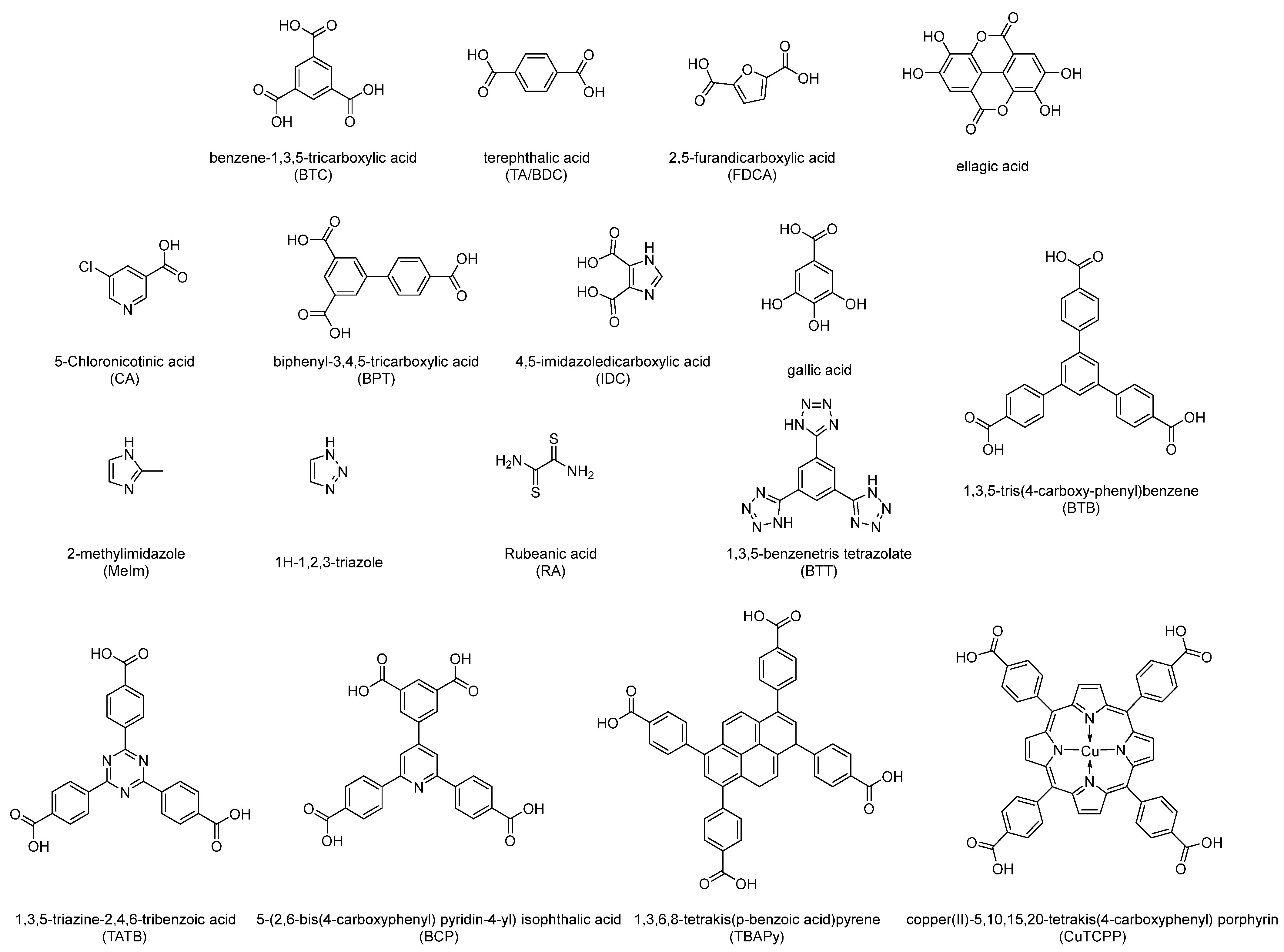

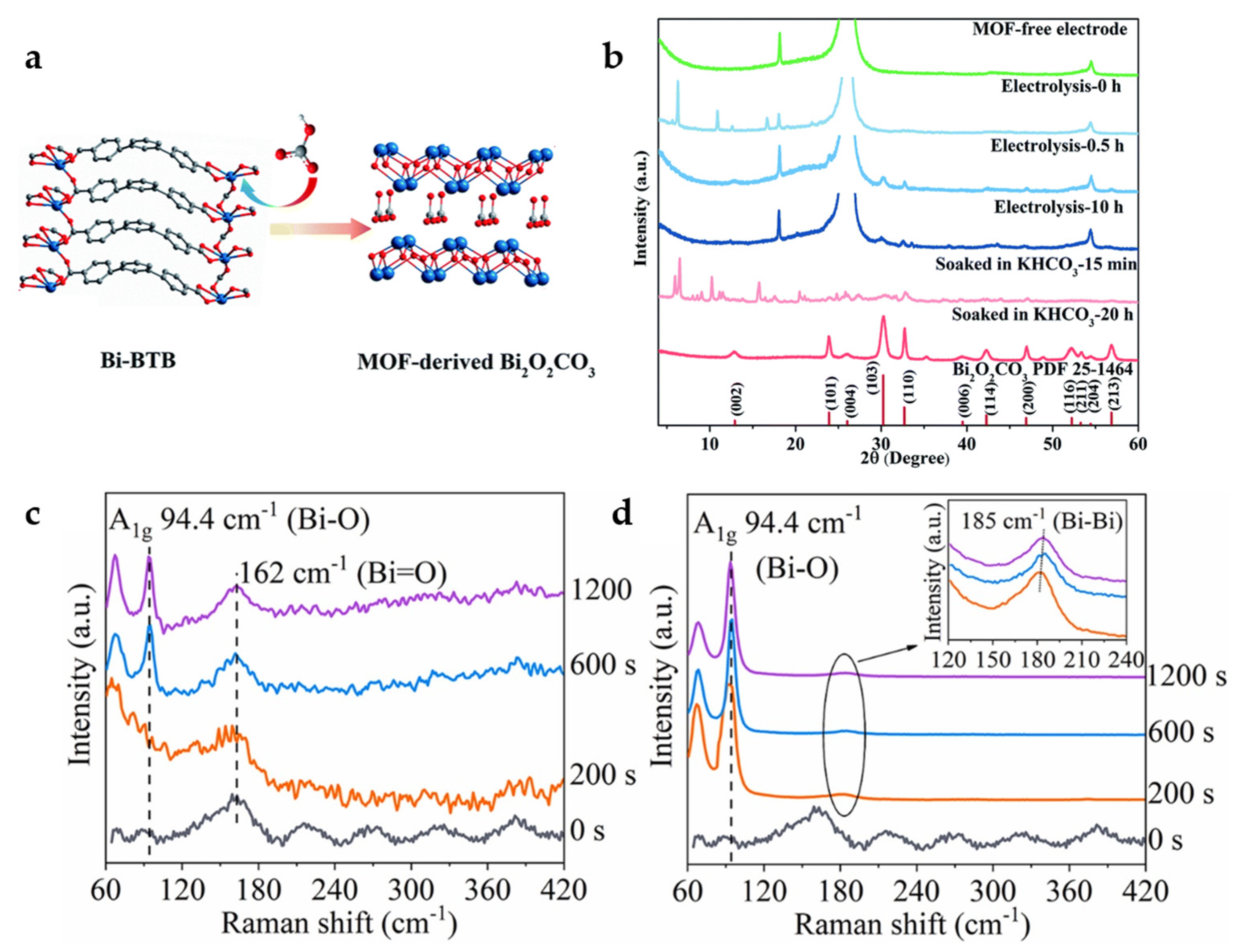

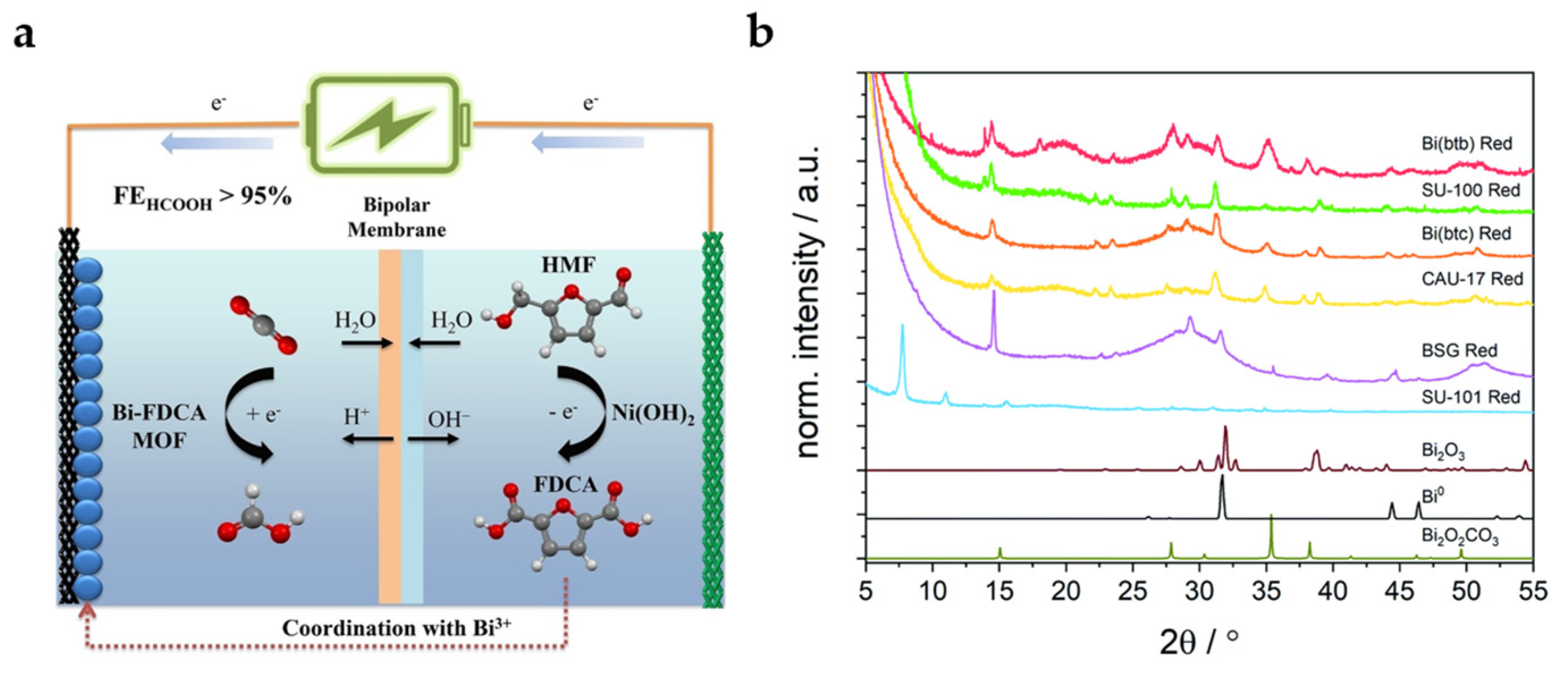

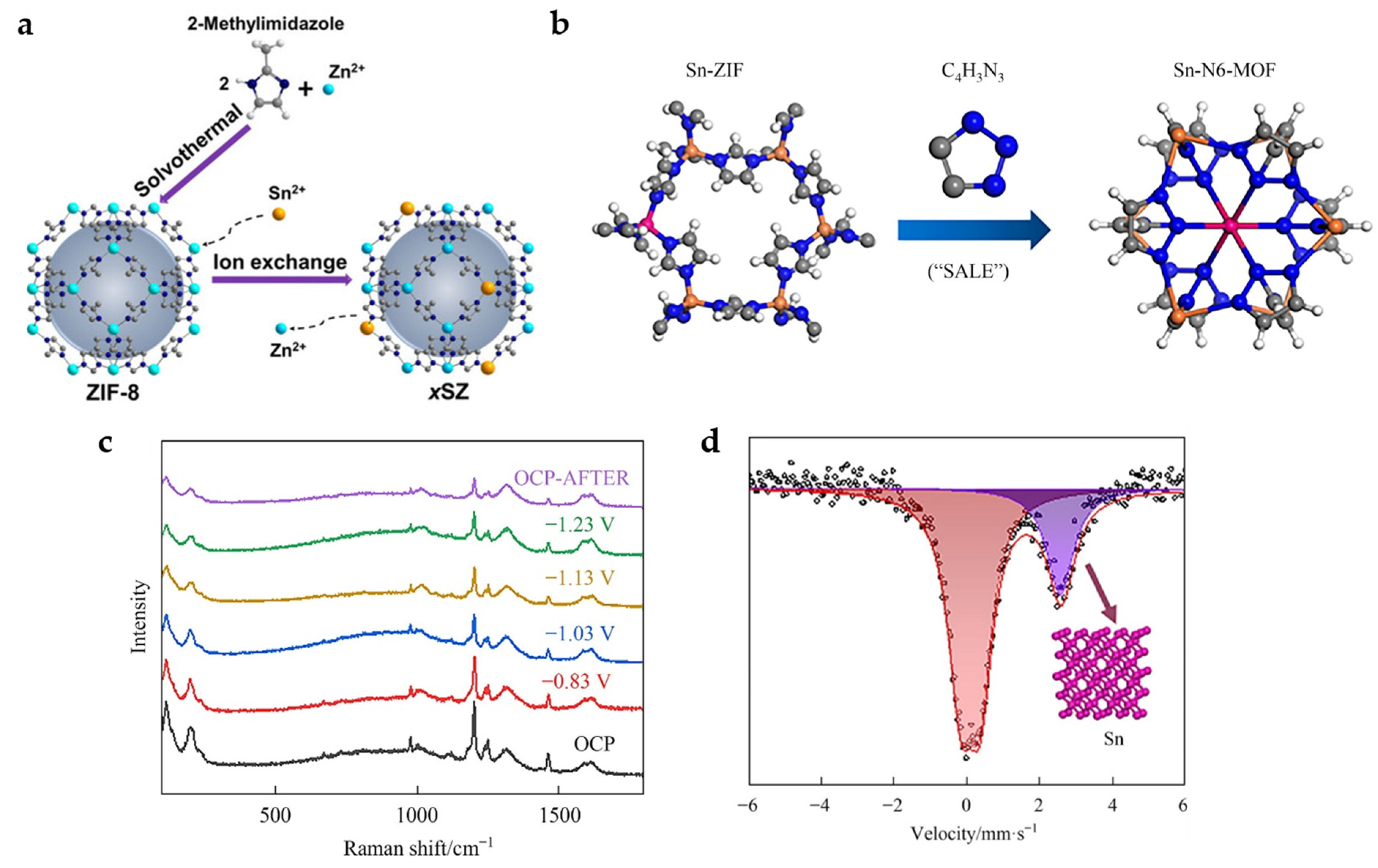
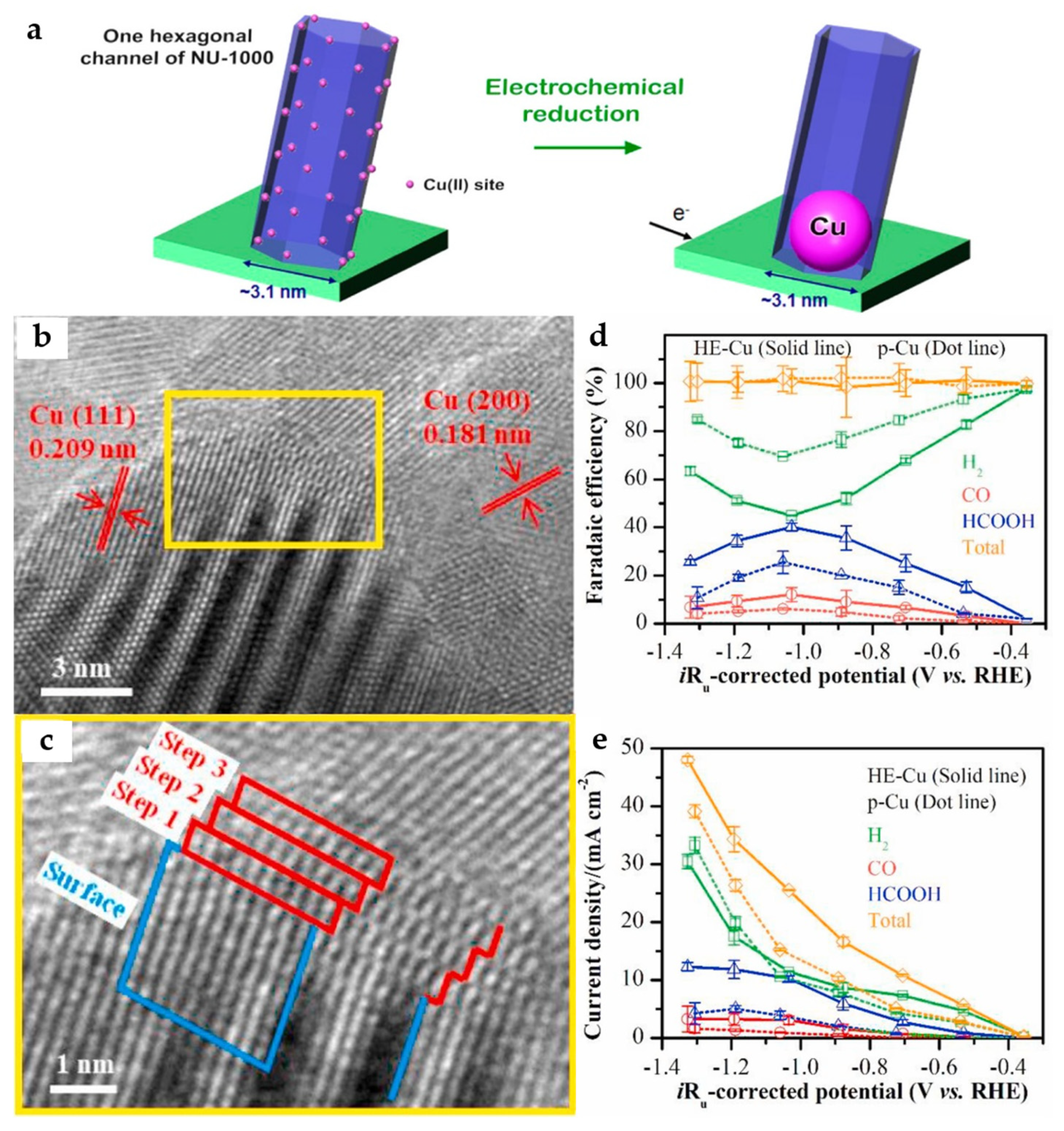
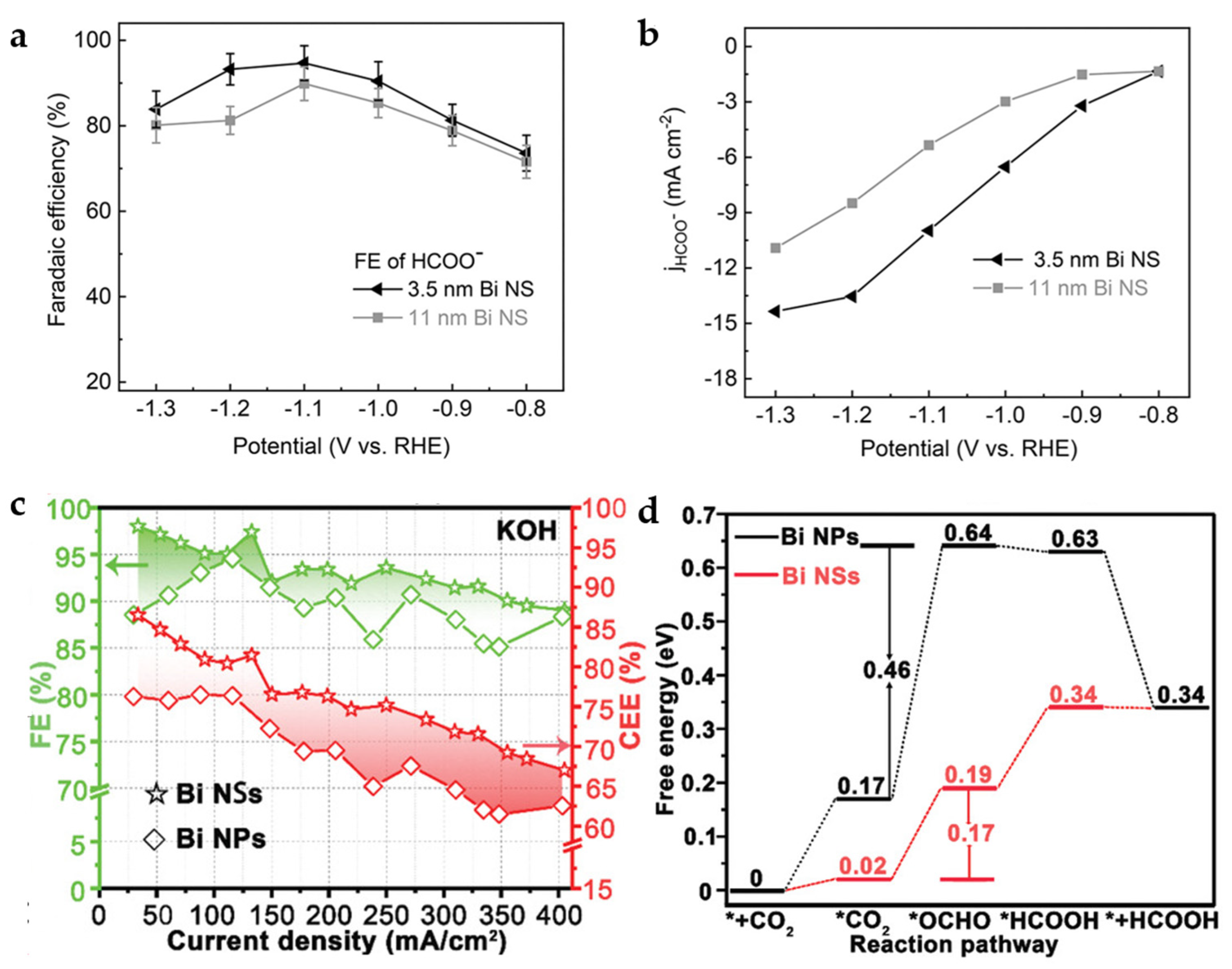



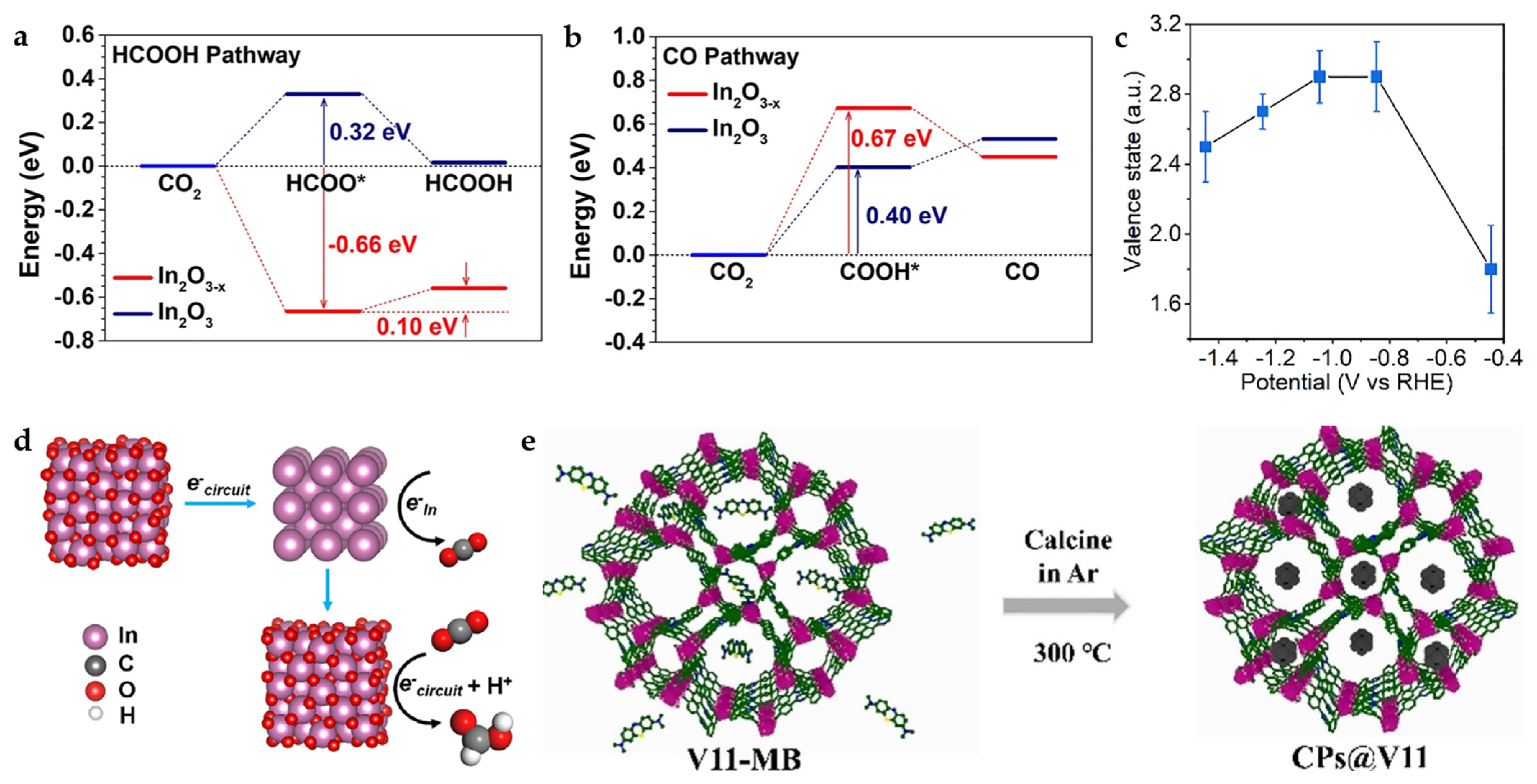

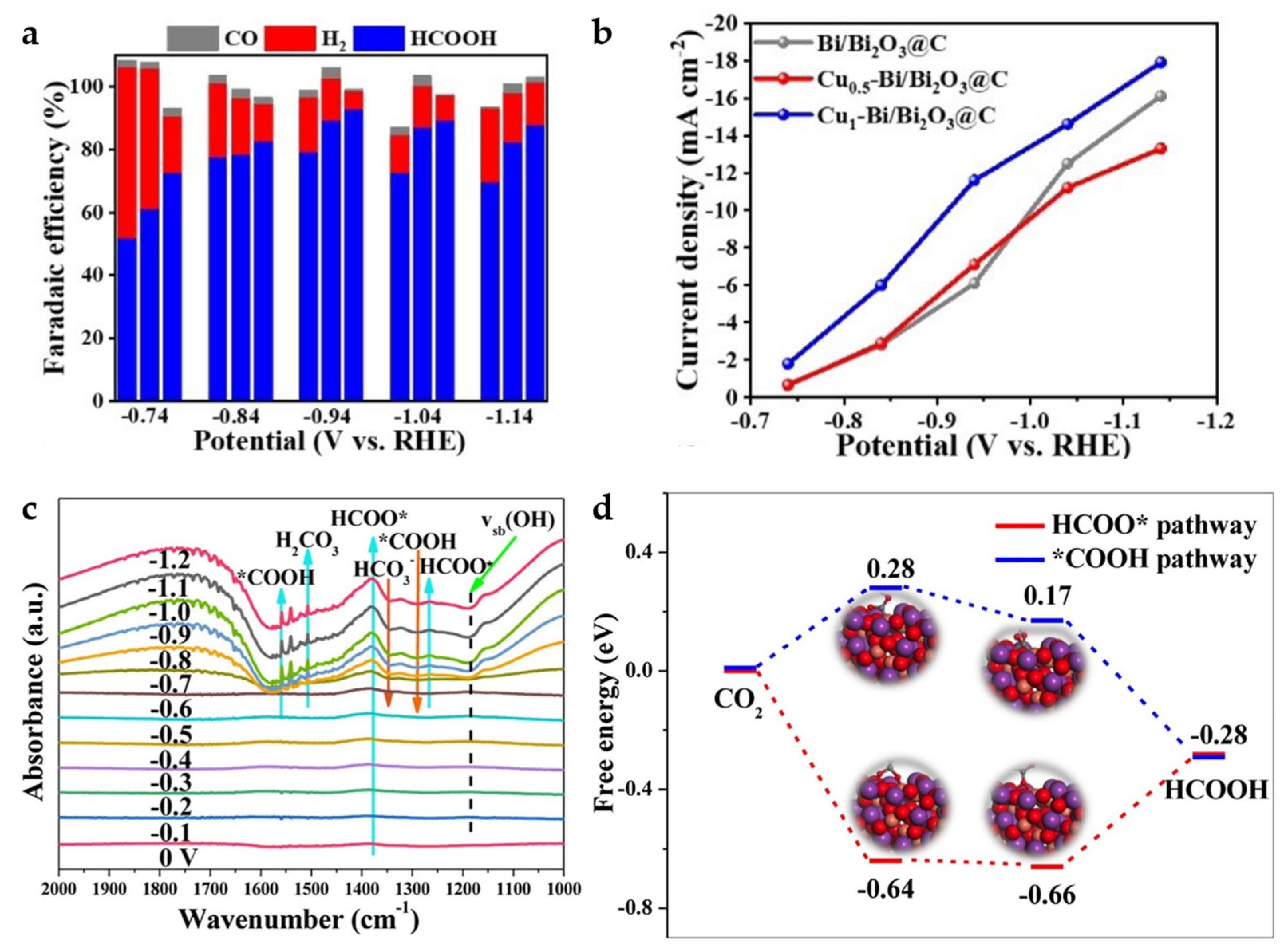
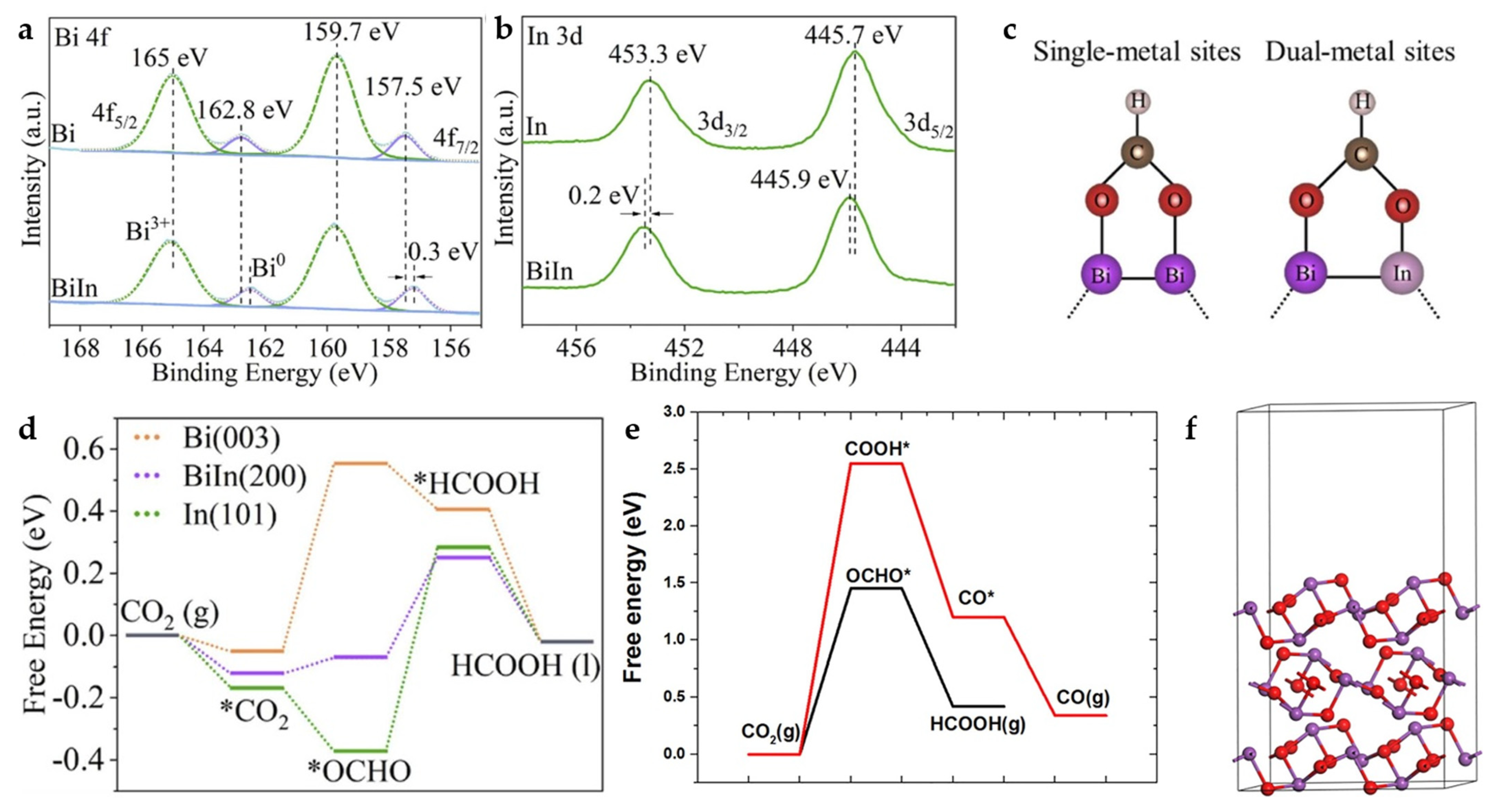

| MOF | Organic Linkers | MOF-Derived Materials | Cell | Electrolyte | Potential (V vs. RHE) | FEHCOOH (%) | Current Density (mA/cm−1) | Stability (h) | Refs. |
|---|---|---|---|---|---|---|---|---|---|
| 1. MOF materials | |||||||||
| CR-MOF (Cu) | BDC | - | H-cell | 0.5 M KHCO3 | −1.2/−1.4/−1.6 vs. SHE | ~>29.4 | - | - | [24] |
| Cu-MOF | BTC | - | H-cell | 0.1 M KHCO3 | −0.1 vs. SCE | 21 | - | - | [33] |
| 0.1 M TBAB/DMF | −0.6 vs. SCE | 58 | - | - | |||||
| Cu2(CuTCPP) | CuTCPP | CuO, Cu2O, and Cu4O3 | H-cell | 1M H2O and 0.5 M EMIMBF4/CH3CN | −1.55 vs. Ag/Ag+ | 68.4 | - | - | [27] |
| PCN-222(Cu) (Zr) | CuTCPP | - | H-cell | 0.5 M KHCO3 | −0.7 | 44.3 | 3.2 | 10 | [34] |
| PCN-224(Cu) (Zr) | CuTCPP | - | 34.1 | 2.4 | 10 | ||||
| Bi-BTB | BTB | Bi2O2CO3 | H-cell | 0.5 M KHCO3 | −0.669 | 96.1 | 13.2 | 48 | [35] |
| −0.969 | 80 | 60.5 | - | ||||||
| Bi-MOF | BTC | Bi and Bi2O2.5 | Flow cell | 1 M KOH | −0.64 | 92 | 150 | - | [36] |
| H-cell | 0.1 M KHCO3 | −1.1 | 80 | 10 | 30 | ||||
| CAU-17 (Bi) | BTC | - | H-cell | 0.1 M KHCO3 | ~−0.9 | 92.2 | - | 30 | [16] |
| Bi-FDCA | FDCA | Bi2O2CO3 | H-cell | 0.1 M KHCO3 | −1.2 | 95.1 | 19.6 | - | [37] |
| Bi-BTB | BTB | Bi2O2CO3 | H-cell | 0.5 M KHCO3 | −0.97 | 95 | 5.4 | - | [38] |
| SU-100 (Bi) | BPT | 90 | 8.0 | - | |||||
| Dense Bi-BTC | BTC | 80 | 4.8 | - | |||||
| CAU-17 (Bi) | BTC | - | - | - | |||||
| SU-101 (Bi) | Ellagic acid | - | - | - | - | ||||
| BSG (Bi) | Gallic acid | Bi2O2CO3 | 85 | 7.6 | - | ||||
| In-BDC | BDC | - | H-cell | 0.5 M KHCO3 | −0.669 | 88 | 7.4 | 21 | [39] |
| 0.6SZ (ZIF-8 with Sn doping) | MeIm | - | H-cell | 0.5 M KHCO3 | −1.1 | 74 | 27 | 7 | [23] |
| Sn-N6-MOF | MeIm and 1H-1,2,3-triazole | Sn nanoclusters | H-cell | 0.5 M KHCO3 | −1.23 | 85 | 23 | 6 | [40] |
| MIL-53 (Al) | BDC | - | Flow cell | 0.05 M K2CO3 | −0.9~−1.1 | 14~19 | - | - | [41] |
| 2. Metal Nanomaterials (Electrochemical Reduction) | |||||||||
| Cu-SIM NU-1000 (Zn) | TBAPy | Cu NPs | H-cell | 0.1 M NaClO4 | −0.82 | 28 | 1.2 | - | [42] |
| H-Cu | BTC | HE-Cu | H-cell | 0.1 M KHCO3 | −1.03 | 40.1 | - | - | [43] |
| CAU-17 (Bi) | BTC | Bi NSs | H-cell | 0.1 M KHCO3 | −1.1 | 92 | ~10.8 | 10 | [44] |
| CAU-17 (Bi) | BTC | Bi NSs | Flow cell | 1 M KOH | −0.48 | 97.4 | 133 | >10 (>200 mA cm−2) | [45] |
| CAU-17 (Bi) | BTC | Bi/CC-17 NSs | H-cell | 0.5 M KHCO3 | −1.1 | 98 | 45 | 48 | [46] |
| Bi-MOF | BDC | BiMNS | H-cell | 0.5 M KHCO3 | −0.8 | 98 | 23.5 | 40 | [47] |
| Bi-MOLs | IDC | Bi-ene | H-cell | 0.5 M KHCO3 | −0.83~−1.18 | ~100 | 72.0 (−1.18 V) | 12 (−0.9 V) | [48] |
| Flow cell | 1M KOH | −0.57/−0.75 | 99.8/99.2 | 100/200 | - | ||||
| Bi-BTB | BTB | Bi NPs | H-cell | 0.5 M KHCO3 | −0.97 | 95 | 5.4 | 32 | [49] |
| Pb-MOF | CA | Pb3(CO3)2(OH)2 (ER-HC) | H-cell | 0.1 M KHCO3 | −0.88 | 96.8 | 2.0 | - | [50] |
| 3. Carbon-based Nanocomposites (Carbonization) | |||||||||
| Cu-BTC | BTC | Cu2O/Cu@NC-800 | H-cell | 0.1 M KHCO3 | −0.68 | 70.5 | - | 30 | [29] |
| Cu-BTT | BTT | Cu–N–C1100 | H-cell | 0.1 M KHCO3 | −0.9 | 38.1 | 3.7 | - | [51] |
| Bi-BTC | BTC | Bi2O3@C | H-cell | 0.5 M KHCO3 | −0.9 | 92 | 8.0 | 10 | [31] |
| Flow cell | 1 M KOH | −0.3~−1.4 | >93% | 1.4–208 | 1 | ||||
| SU101 (Bi) | Ellagic acid | SOR Bi@C NPs | H-cell | 0.5 M KHCO3 | −0.99 | 95 | 11.1 | 18 (−1.0 V) | [52] |
| Flow cell | 1 M KOH | −1.12 | 90 | 100 | - | ||||
| MIL-68 (In) | BDC | In2O3−x@C MIL-68-N2 | Flow cell | 1 M KOH | −0.4/−1 | 84/97 | 13.1/221.65 | 120 (−1.0 V) | [53] |
| V11 (In) | BCP | CPs@V11 | H-cell | 0.5 M KHCO3 | −0.84 | 90.1 | 7.62 | 20 | [54] |
| ZIF-8 (Zn) | MeIm | In-SAs/NC | H-cell | 0.5 M KHCO3 | −0.65 | 96 | 8.9 | - | [55] |
| ZIF-8 (Zn) | MeIm | In−N−C | H-cell | 0.5 M KHCO3 | −0.79 | 80 | 8.5 | 20 | [56] |
| 4. Bimetallic Nanocomposites | |||||||||
| Cu, Bi bi-MOF | BTC | Cu1-Bi/Bi2O3@C (Carbonization) | H-cell | 0.5 M KHCO3 | −0.94 | 93 | ~11.5 | 10 | [22] |
| CuBi-MOF | BTC | CuBi75 (Carbonization) | H-cell | 0.5 M KHCO3 | −0.77 | 100 | - | 24 | [57] |
| In-Bi-MOF | BTC | Bi-In alloy NPs (Electrochemical Reduction) | H-cell | 0.1 M KHCO3 | −1.1 | 97.6 | - | 30 | [58] |
| flow cell | 1M KOH | −0.92 | 97.8 | 250 | - | ||||
| MEA | 0.1 M KHCO3 | - | - | - | 25 (120 mA cm−2) | ||||
| Bi-In-MOF | BTC | BiIn5-500@C (Carbonization) | H-cell | 0.5 M KHCO3 | −0.86 | 97.5 | 13.5 | 15 | [59] |
| MOF-808 (Zr) | BTC | M-AuPd(20) (Chemical Reduction) | H-cell | 0.1 M KHCO3 | −0.25 | >99 | ~7 | - | [18] |
Disclaimer/Publisher’s Note: The statements, opinions and data contained in all publications are solely those of the individual author(s) and contributor(s) and not of MDPI and/or the editor(s). MDPI and/or the editor(s) disclaim responsibility for any injury to people or property resulting from any ideas, methods, instructions or products referred to in the content. |
© 2023 by the authors. Licensee MDPI, Basel, Switzerland. This article is an open access article distributed under the terms and conditions of the Creative Commons Attribution (CC BY) license (https://creativecommons.org/licenses/by/4.0/).
Share and Cite
Xie, W.-J.; Mulina, O.M.; Terent’ev, A.O.; He, L.-N. Metal–Organic Frameworks for Electrocatalytic CO2 Reduction into Formic Acid. Catalysts 2023, 13, 1109. https://doi.org/10.3390/catal13071109
Xie W-J, Mulina OM, Terent’ev AO, He L-N. Metal–Organic Frameworks for Electrocatalytic CO2 Reduction into Formic Acid. Catalysts. 2023; 13(7):1109. https://doi.org/10.3390/catal13071109
Chicago/Turabian StyleXie, Wen-Jun, Olga M. Mulina, Alexander O. Terent’ev, and Liang-Nian He. 2023. "Metal–Organic Frameworks for Electrocatalytic CO2 Reduction into Formic Acid" Catalysts 13, no. 7: 1109. https://doi.org/10.3390/catal13071109
APA StyleXie, W.-J., Mulina, O. M., Terent’ev, A. O., & He, L.-N. (2023). Metal–Organic Frameworks for Electrocatalytic CO2 Reduction into Formic Acid. Catalysts, 13(7), 1109. https://doi.org/10.3390/catal13071109







